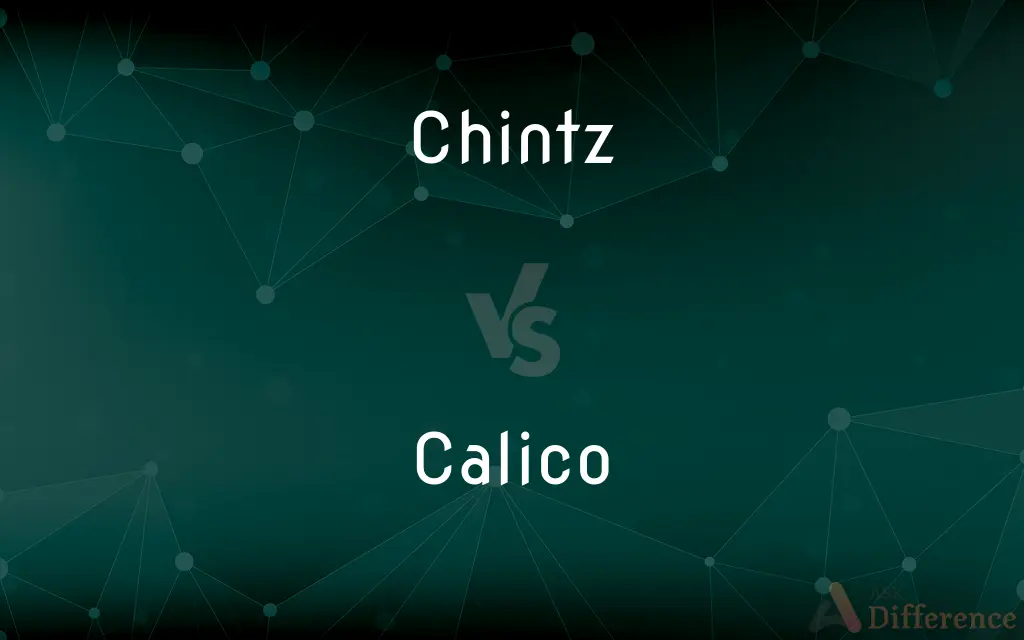Chintz vs. Calico — What's the Difference?
By Maham Liaqat & Urooj Arif — Updated on April 30, 2024
Chintz is a polished cotton fabric with floral designs, used mainly for upholstery and draperies, while calico is a plain-woven textile made from unbleached cotton, often used for quilts.

Difference Between Chintz and Calico
Table of Contents
ADVERTISEMENT
Key Differences
Chintz fabric is known for its glazed appearance, which gives it a shiny finish, making it popular for decorative purposes in home decor. On the other hand, calico is a more humble, unglazed fabric that retains the natural color of unbleached cotton, and is favored for its rustic charm and durability.
Chintz often features elaborate floral patterns that are printed onto the fabric. These designs are typically colorful and detailed, lending an elegant and refined look to the material. Whereas, calico prints are simpler and less detailed, often embodying more basic, repetitive motifs that convey a more casual and homespun feel.
The glazing process in chintz involves coating the fabric with starches and waxes, which not only enhance its aesthetic but also add to its texture, making it stiffer. Calico lacks this finish, resulting in a softer and more flexible fabric that is easier to handle and sew.
Chintz is primarily used in interior decoration for items like curtains, upholstery, and slipcovers due to its decorative appeal and robust texture. Calico, in contrast, is commonly used in dressmaking and for crafting quilts, owing to its comfort and ease of use.
Historically, chintz was originally imported from India and became popular in Europe for its exotic patterns and luxurious sheen. Calico, while also originating from India, was adopted more widely for everyday use and utilitarian garments, reflecting its practical nature.
ADVERTISEMENT
Comparison Chart
Texture
Glazed and shiny
Unglazed and softer
Design
Floral and elaborate
Simple and repetitive
Main Use
Decorative home items like draperies
Quilting and everyday clothing
Finish
Starches and waxes give a polished finish
No finishing, retains natural cotton texture
Historical Popularity
Favored in Europe for luxury decor
Widely used for practical, everyday items
Compare with Definitions
Chintz
A printed multicolored cotton fabric with a glazed finish, usually used for decoration.
The living room had an old-world charm with its chintz-covered sofas.
Calico
Plain-woven cotton fabric, typically not dyed or bleached.
She preferred calico for her sewing projects because it was easy to work with.
Chintz
Fabric treated with a glaze, giving it a shiny surface.
The chintz curtains reflected the sunlight, brightening the room.
Calico
Commonly used in quilting and as a utility fabric.
The quilt displayed a beautiful patchwork of colorful calico scraps.
Chintz
Traditionally imported from India, known for floral designs.
Her collection of vintage chintz from the 18th century was quite impressive.
Calico
Retains a natural, rustic look.
The rustic look of calico curtains complemented the cottage’s aesthetic perfectly.
Chintz
Used primarily for upholstery and draperies.
The designer recommended chintz for the window treatments to add a touch of elegance.
Calico
Known for its simple, unpretentious appearance and durability.
The calico aprons were perfect for the art class, durable and easy to clean.
Chintz
Often features a polished texture.
The polished texture of the chintz made it the highlight of her textile exhibit.
Calico
Often less expensive and more accessible than other fabrics.
They used calico for the mock-up designs to keep costs down.
Chintz
Chintz () is a woodblock printed, painted, stained or glazed calico textile that originated in Golconda (present day Hyderabad, India) in the 16th century. The cloth is printed with designs featuring flowers and other patterns in different colours, typically on a light, plain background.
Calico
Calico (; in British usage since 1505) is a plain-woven textile made from unbleached, and often not fully processed, cotton. It may also contain unseparated husk parts.
Chintz
A printed and glazed cotton fabric, usually of bright colors.
Calico
A tightly woven cotton cloth having a repeating, often floral design.
Chintz
A painted or stained calico fabric, originally produced in India, and known for its brightly colored designs.
Calico
Chiefly British A plain white cotton cloth, heavier than muslin.
Chintz
Cotton cloth, printed with flowers and other devices, in a number of different colors, and often glazed.
Calico
An animal, such as a cat, having a coat of white fur with distinct patches of different colors, usually reddish-orange and black.
Chintz
A brightly printed and glazed cotton fabric
Calico
(textiles) A kind of rough cloth made from unbleached and not fully processed cotton, often printed with a bright pattern.
Calico
Ellipsis of calico cat
Calico
(uncountable) The plant disease caused by Tobacco mosaic virus.
Calico
Made of calico or resembling the color of calico cloth, having a pattern of red and contrasting areas; variegated.
The calico cat had distinctive red and dark markings.
The calico-patterned tablecloths were supposed to make the restaurant look rustic; instead, they made it look run down.
Calico
Plain white cloth made from cotton, but which receives distinctive names according to quality and use, as, super calicoes, shirting calicoes, unbleached calicoes, etc.
The importation of printed or stained colicoes appears to have been coeval with the establishment of the East India Company
Calico
Cotton cloth printed with a figured pattern.
Calico
Made of, or having the appearance of, calico; - often applied to an animal, as a horse or cat, on whose body are large patches of a color strikingly different from its main color.
Calico
Coarse cloth with a bright print
Calico
Made of calico or resembling calico in being patterned;
Calico dresses
A calico cat
Calico
Having sections or patches colored differently and usually brightly;
A jester dressed in motley
The painted desert
A particolored dress
A piebald horse
Pied daisies
Common Curiosities
How should chintz be cared for to maintain its glaze?
Chintz should be dry cleaned or carefully hand washed to avoid wearing off its glazed finish.
What is the primary difference between chintz and calico?
Chintz is glazed and often floral-printed, used for decorative purposes, while calico is plain, unglazed, and used for practical items.
Why is chintz often more expensive than calico?
Chintz is typically more expensive due to its complex printing processes and the glazing treatment it undergoes, which add to the production costs.
Can chintz be used for clothing?
Yes, chintz can be used for clothing, especially in vintage or traditional designs, though it is more common in home decor.
Are there eco-friendly versions of calico available?
Yes, organic calico made from cotton grown without pesticides and processed without harmful chemicals is available for those seeking eco-friendly fabric options.
What historical significance do chintz and calico have?
Both fabrics have significant historical roots, with chintz being prized in European colonial times for its exotic appeal, and calico being integral to the textile industry during the Industrial Revolution.
What are the environmental impacts of producing chintz and calico?
The production of chintz can have a higher environmental impact due to the chemicals used in the glazing process, whereas calico, especially if unbleached and untreated, tends to be more environmentally friendly.
Is calico suitable for outdoor furniture covers?
Calico is not ideal for outdoor furniture as it lacks the necessary durability and weather resistance that outdoor fabrics require.
Is chintz still popular in modern interior design?
Chintz has seen a resurgence in popularity in modern interior design, particularly in styles that favor a classic or vintage aesthetic.
Which fabric is better for someone starting a sewing project for the first time?
Calico is generally recommended for beginners due to its ease of handling and forgiving nature, making it ideal for practice and simple projects.
How does the weight of chintz compare to calico?
Chintz is generally heavier than calico due to its glazed finish and denser weave.
Can calico be printed like chintz?
Yes, calico can be printed with designs, but the prints are usually less intricate and vibrant compared to those on chintz.
Can both chintz and calico be dyed to any color?
Both fabrics can be dyed, but chintz, with its pre-existing prints and glaze, may not take new colors as easily as the more absorbent calico.
How do the care requirements of chintz and calico differ?
Chintz usually requires dry cleaning to preserve its finish and colors, while calico can often be machine washed, making it easier to care for.
Share Your Discovery

Previous Comparison
Autograph vs. Autogram
Next Comparison
Conflict vs. ClimaxAuthor Spotlight
Written by
Maham LiaqatCo-written by
Urooj ArifUrooj is a skilled content writer at Ask Difference, known for her exceptional ability to simplify complex topics into engaging and informative content. With a passion for research and a flair for clear, concise writing, she consistently delivers articles that resonate with our diverse audience.













































